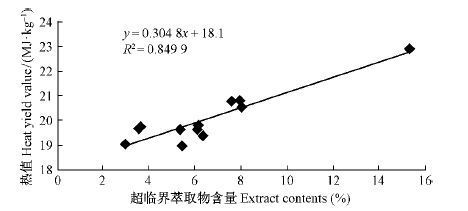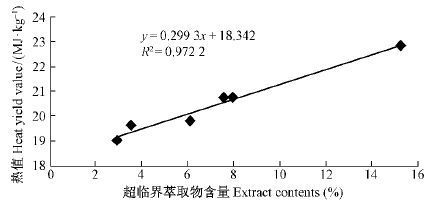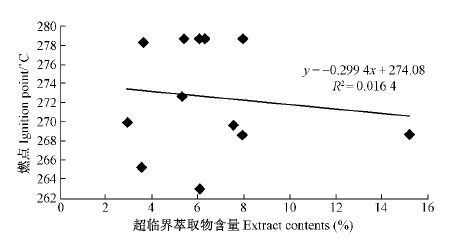文章信息
- 赵凤君, 王秋华, 舒立福, 杨丽君, 刘柯珍
- Zhao Fengjun, Wang Qiuhua, Shu Lifu, Yang Lijun, Liu Kezhen
- 大兴安岭针叶可燃物的热值和燃点与其超临界萃取物含量的相关性
- Correlations between Supercritical Extracts of Coniferous Fuel and the Heat Yield Value and Ignition Point
- 林业科学, 2016, 52(4): 68-74
- Scientia Silvae Sinicae, 2016, 52(4): 68-74.
- DOI: 10.11707/j.1001-7488.20160408
-
文章历史
- 收稿日期:2014-07-18
- 修回日期:2015-11-20
-
作者相关文章
- ,
- ,
- ,
- ,
2. 西南林业大学 昆明 650224;
3. 大兴安岭林业集团科研推广站 加格达奇 165000
2. Southwest Forestry University Kunming 650224;
3. Research Station, Daxing'anling Mountain Forestry Group Jiagedaqi 165000
尽管森林可燃物的形态千差万别,但其化学组分相似,可归结为5大类: 纤维素 (38%~50%)、半纤维素(7%~26%)、木质素(23%~24%)、抽提物(<15%)、矿物质(<1%)(Barboni et al., 2010)。纤维素和半纤维素的热学性质差别不大,热值为16.13 MJ·kg-1; 木质素的热值为24.53 MJ·kg-1(郑焕能,1992)。抽提物的成分较复杂,其中脂肪类物质和萜烯类组分对燃烧和火行为影响较大(李艳芹等,2008)。脂肪类物质主要包括脂肪和蜡,俗称“粗脂肪”,热值为35~40 MJ·kg-1(Wickens,2001),为可燃物化学组分中热值最高的;萜烯类的主要组分为单萜(monoterpenes)和倍半萜(sesquiterpenes)(Cannac et al., 2009),俗称“挥发性油”,热值约为32.36 MJ·kg-1(郑焕能等,1992)。脂肪类物质对于可燃物燃烧的贡献主要在于其热值高,燃烧时能释放出大量热能,使火强度增大(郑焕能等,1992)。挥发性油对于可燃物燃烧的贡献主要在于其沸点低,受热易挥发; 富含挥发性油的可燃物在纤维素等组分热裂解前可生成较多的易燃气体,利于林火的引燃和燃烧,且易导致火旋风、树冠火等(Zhao et al., 2011; 2013)。
抽提物含量及其与燃烧和火行为的关系一直是林火研究的热点。抽提物中脂肪类物质的提取通常利用脂肪能溶于脂溶性有机溶剂的特性,首先将脂肪提取出来,再借助蒸发除去溶剂; 整个提取过程可在索式提取器中进行,抽提时间一般不少于6 h(单延龙等,2003)。挥发性油组分的获得则利用挥发性油与水不相溶的原理,采用水蒸气蒸馏的方法进行提取,通常蒸馏时间不少于6 h(陈存及等,1995),蒸馏液经除水处理后,可得挥发性油。上述提取方法虽然最终可获得可燃物中的粗略抽提物,满足不同可燃物间抽提物含量差异的比较,但却存在着操作繁琐、耗时长、提取效率低等缺点。
超临界CO2流体萃取技术是当前提取天然产物各化学组分的常用方法,广泛应用于食品(佟健,2006)、药物(张忠义等,2003)、化妆品(Coelho et al., 2012)、环境监测(张凤娟等,2007) 等领域。超临界萃取物化学组分非常复杂,多达200种(Coelho et al., 2012),萃取压力、萃取温度、萃取时间、被萃取物颗粒大小及不同品种的夹带剂等都是导致所获得萃取物组分和含量差异的原因(Sovilj et al., 2011; Mic' ic' et al., 2011; Pourmortazavi et al., 2007; Omar et al., 2013),因此需针对预期萃取组分设计相对应的超临界萃取条件。
大兴安岭林区是我国重要的用材林区,也是我国森林火灾发生较严重的地区之一,其地带性植被为兴安落叶松(Larix gmelinii)林,主要针叶树种有兴安落叶松、樟子松(Pinus sylvestris var. mongolica)、偃松(Pinus pumila)、鱼鳞云杉(Picea jezoensis)、红皮云杉(Picea koraiensis)、兴安桧(Sabina davurica)等。本文对该区域主要针叶树可燃物的超临界萃取物与热值和燃点的相关性进行研究,旨在寻求简单、快速、准确获取可燃物抽提物含量的方法和技术,为林火管理提供理论和数据支撑。
1 材料与方法 1.1 可燃物样品采集可燃物样品采自6个针叶树种,树种名称及采集地点见表 1。
|
|
每个树种选择3~5株生长健康、无病虫害的树木,从各个生长方向 分别按针叶和小枝采集样品。取针叶和小枝各1 000 g,用脱脂棉擦拭掉表面的尘土,置于实验室阴凉通风处,约1个月后样品含水量恒定,得到风干后可燃物。为避免可燃物样品中抽提物组分在烘干状态下损失,未采用烘箱烘干处理。
1.2 风干可燃物样品粉碎风干后的可燃物样品用植物粉碎机粉碎,过40目筛,存于封口袋中备用。对樟子松针叶,分别获取10,20,60目的样品。
1.3 风干可燃物样品含水率测定取粉碎后风干可燃物样品约20 g,102 ℃烘干至恒质量,用下式计算样品含水率: $$H(\%)= {{{W_1} - {W_2}} \over {{W_2}}} \times 100$$ 式中: H为样品含水率; W1,W2分别为烘干前后样品质量。
1.4 超临界萃取条件的优选萃取时载气选用99.9%纯度的CO2气体。通过比较不同萃取条件下50 g樟子松针叶超临界萃取物含量,对萃取条件进行优选。试验时保持其他条件参数不变,只针对1项条件的不同参数进行试验,共进行5项试验,每项条件参数分别设置如下: 气体流速为1.0,1.5,2.0,2.5 L·min-1;萃取釜温度为35,40,45,50 ℃;萃取釜压力为10,20,30,40,50 MPa;样品粒度为10,20,40,60目;收集时间为20,40,60,80,100,120 min。
1.5 超临界萃取物的获取取50 g粉碎的风干可燃物样品(40目)置于300 mL超临界萃取釜中,按获得的萃取优选条件设置萃取釜温度、萃取釜压力、收集时间、CO2气体流速。 用已知质量的可密闭玻璃瓶接收超临界萃取物,瓶质量的增加值即为超临界萃取物的绝对质量M1。重复测定3次。可燃物中超临界萃取物含量R(%)用下式计算: $$R(\%)= {{{M_1}} \over {50}} \times 100 \div H(\%)$$ 式中:R为超临界萃取物含量; M1为50 g风干可燃物样品中超临界萃取物的绝对质量; H为风干可燃物样品的含水率。
1.6 可燃物样品热值的测定采用美国PARR 6300全自动氧弹量热仪测定可燃物样品的热值,每个样品测定3~5次,测定值误差限定在1%范围。
1.7 可燃物样品燃点的测定采用DW-2点着温度测定仪测定可燃物样品的燃点,每个样品测定3~5次,测定值误差限定在±0.5 ℃。
2 结果与分析 2.1 最优超临界萃取条件由表 2可知:收集时间为20 min时,萃取物含量最低,仅3.16%;随收集时间延长,萃取物含量逐渐增加; 收集时间为80 min时,萃取物含量为5.72%;收集时间延长到100和120 min时,萃取物含量仅有微量增加,分别为5.73%和5.74%。因此,选定80 min作为最优收集时间。
|
|
由表 3可知:样品粒度为10目时萃取物含量最低,为3.61%;随样品粒度变小,萃取物含量逐渐增加;样品粒度为60目时,萃取物含量最大,为6.27%。由于样品粒度在40目和60目时,萃取物含量差异不大,分别为6.20%和6.27%,虽然以60目最优,但40目样品更易获得,因此,选定40目作为最适宜样品粒度。
|
|
由表 4可知:CO2气体流速为1.0 L·min-1时,萃取物含量最低,为4.68%;随CO2气体流速增加,萃取物含量逐渐增加。但CO2气体流速为1.5,2.0,2.5 L·min-1时,萃取物含量差异不大,因此,选定2.0 L·min-1为最优气体流速。
|
|
由表 5可知:萃取釜压力为10 MPa时,萃取物含量最低,为1.25%;随萃取釜压力增加, 萃取物含量逐渐增加;在40 MPa时达到最大6.68%;50 MPa时又略有下降。因此,选定40 MPa 为最优萃取釜压力。
|
|
由表 6可知:萃取釜温度为35 ℃时,萃取物含量较低,为7.33%;随萃取釜温度升高,萃取物含量逐渐增加; 萃取釜温度为45 ℃时,萃取物含量最高,为7.93%; 萃取釜温度升到50 ℃时,萃取物含量略有下降。因此,选定45 ℃为最优萃取釜温度。 综上所述,以样品粒度40目、萃取釜温度45 ℃、萃取釜压力40 MPa、CO2气体流速2.0 L·min-1、萃取物收集时间80 min为最佳超临界萃取条件。
|
|
由表 7可知:针叶树可燃物样品的超临界萃取物含量、热值和燃点的平均值分别为6.51%,20.08 MJ·kg-1和272.6 ℃。
|
|
可燃物样品的超临界萃取物含量最高的是兴安桧的针叶(15.28%);较高的有兴安桧的小枝(8.00%)、樟子松和偃松的针叶(7.93%和7.55%);然后是兴安落叶松的小枝(6.30%)和鱼鳞云杉的针叶(6.10%); 最低的是兴安落叶松的针叶(2.92%),仅约为兴安桧针叶的19%。
可燃物样品的热值最高的是兴安桧针叶(22.89 MJ·kg-1);较高的有樟子松针叶(20.80 MJ·kg-1)、偃松针叶(20.78 MJ·kg-1)和兴安桧小枝(20.56 MJ·kg-1); 较低的是兴安落叶松针叶(19.05 MJ·kg-1)和小枝(19.41 MJ·kg-1),最低的是红皮云杉小枝(18.96 MJ·kg-1)。
可燃物样品的燃点最低的是鱼鳞云杉针叶(263.0 ℃);较低的有红皮云杉针叶(265.3 ℃)、兴安桧针叶(268.7 ℃)、樟子松针叶(268.7 ℃)、偃松针叶(269.7 ℃)和兴安落叶松针叶(270.0 ℃);较高的有红皮云杉小枝、兴安落叶松小枝、樟子松小枝和兴安桧小枝,均为278.7 ℃。
2.3 可燃物样品热值与其超临界萃取物含量的相关性图 1表明,可燃物样品热值与其超临界萃取物含量 密切相关,相关系数为0.849 9,尤其是针叶样品的热值与其超临界萃取物含量的相关系数达到0.972 2(图 2)。

|
图1 可燃物样品热值与超临界萃取物含量的相关性 Fig.1 Correlation of extract contents and heat yield value( needles and twigs) |

|
图2 针叶可燃物样品热值与其超临界萃取物含量的相关性 Fig.2 Correlation of extract contents and heat yield value( needles) |
图 3表明,可燃物样品燃点与其超临界萃取物含量无显著相关,相关系数仅为0.016 4; 虽然针叶样品的燃点与其超临界萃取物含量的相关系数略有提高,也仅为0.046 0(图 4),表明二者无显著相关。

|
图3 可燃物样品燃点与其超临界萃取物含量的相关性 Fig.3 Correlation of extract contents and ignition point( needles and twigs) |

|
图4 针叶可燃物样品燃点与其超临界萃取物含量的相关性 Fig.4 Correlation of extract contents and ignition point( needles) |
热值和燃点是表征可燃物燃烧性的2个重要指标。本研究中可燃物样品超临界萃取物含量与热值密切相关,而与燃点无显著相关,这是由抽提物自身的理化性质和试验所设置的超临界萃取条件决定的。
植物样品的抽提物组分非常复杂,每种组分都有其各自的理化性质,如沸点、分子质量等(Coelho et al., 2012)。抽提物中与可燃物燃烧性相关的物质主要有2类,即挥发性油和脂肪类物质(李艳芹等,2008)。脂肪类物质由于具有高热值,因此与可燃物燃烧释放的热量密切相关(郑焕能等,1992)。挥发性油沸点低,特别是单萜类挥发性油,当可燃物样品处于不足200 ℃的热环境中时,就可以释放大量易燃气体(Zhao et al., 2013; Chetehouna et al., 2009),在此温度下纤维素、半纤维素和木质素组分尚未开始热裂解(Mohan et al., 2006; Yang et al., 2007)。因此,Pompe等(1966)认为,尽管挥发性油具有较高热值,但由于含量少,释放的热量在可燃物燃烧释放总热量中所占比例较低,其对林火行为的重要影响主要表现在林火发生初期,特别是在可燃物仍含有大量水分的情况下,因为挥发性油受热生成易燃气体所需的能量远低于纤维素等物质裂解生成易燃气体所需的能量。Ormeño等(2009)的研究结果也表明,富含挥发性油的可燃物引燃时间短。
挥发性油属于抽提物中的低沸点组分,而脂肪类物质则属于抽提物中的高沸点组分。超临界萃取技术的优越性在于可通过设置不同的超临界萃取条件而获得不同的目标组分(Mi Dc' i Dc' et al., 2011; Pourmortazavi et al., 2007; Omar et al., 2013)。随着萃取温度升高、压力增大、萃取时间延长,超临界流体CO2的溶解力增强,所获得的萃取物沸点增高、分子质量增大。随着CO2的溶解力增强,萃取物中依次出现物质的顺序为挥发性油、高级萜烯酯类、游离脂肪酸、脂肪油、蜡、树脂、色素(Sovilj et al., 2011)。本研究结果与上述文献的结论一致,萃取物含量与热值密切相关,表明萃取物中的主要组分为脂肪类物质,同时也表明试验所设萃取条件(萃取温度45 ℃、萃取压力40 MPa、收集时间80 min、分离流速2.0 L·min-1)适于萃取脂肪类抽提物。
近年来国内外文献报道表明,挥发性油与林火行为特别是特殊火行为(火旋风、飞火、火暴等)以及林火行为的突变具有密切关系(Zhao et al., 2013; Chetehouna et al., 2009; Barboni et al., 2011; Courty et al., 2012),因此准确获取可燃物挥发性油组分的含量是开展相关研究的基础,但由于挥发性油特有的低沸点性质,准确获取其含量有很大困难。鉴于超临界萃取技术在提取天然产物方面的卓越表现及其可灵活调控的萃取条件, 找到适宜的提取挥发性油的超临界萃取条件是完全可能的。
3.2 结论本研究优选出的超临界萃取条件,即样品粒度40目、萃取釜温度45 ℃、萃取釜压力40 MPa、收集时间80 min、气体流速2.0 L·min-1,是获得可燃物样品中脂肪类抽提物的最适条件。此条件下的萃取物含量与可燃物样品的热值密切相关,特别是针叶样品的相关系数达到0.972 2。应用本研究确定的方法,可快速测定可燃物样品中的脂肪类抽提物含量,与传统的索氏提取器方法相比,具有操作简单、耗时短、提取效率高等优点。
大兴安岭林区主要针叶树种,脂肪类抽提物含量最高的是兴安桧的针叶,较高的是兴安桧的小枝、樟子松和偃松的针叶,而兴安落叶松针叶的萃取物含量最低。
用本研究方法获得的超临界萃取物含量与可燃物燃点无显著相关,主要原因在于所设置超临界条件不适宜挥发油性物质的提取。
| [1] |
陈存及, 何宗明, 陈东华, 等. 1995. 37种针阔树种抗火性能及其综合评价的研究. 林业科学, 31(2):133-143. (Chen C J, He Z M, Chen D H, et al. 1995. Studies on the fire-resistance of 37 species of coniferous and broadleaf trees and it's appraisal. Scientia Silvae Sinicae, 31(2):133-143.[in Chinese])(  1) 1)
|
| [2] |
李艳芹, 胡海清. 2008. 森林可燃物抽提物研究综述. 世界林业研究, 21(6):54-56. (Li Y Q, Hu H Q. 2008. Summary of research on forest combustible extract. World Forestry Research, 21(6):54-56.[in Chinese])(  1) 1)
|
| [3] |
单延龙, 李 华, 齐齐格. 2003. 黑龙江大兴安岭主要树种燃烧性及理化性质的实验分析.火灾科学, 12(2):74-78. (Shan Y L, Li H, Qi Q G. 2003. Experimental analysis of the burning and physicochemical property of principal species in Daxing'an Mountain, Heilongjiang Province. Fire Safety Science, 12(2):74-78.[in Chinese])(  1) 1)
|
| [4] |
佟健. 2006. 香叶中挥发性组分的超临界萃取及气相色谱-质谱分析. 质谱学报, 27(2):94-99. (佟健, 2006. Analysis of volatile constituents from Lindera communisHemsl.by supercritical fluid extraction gas chromatography mass spectrometry. Journal of Chinese Mass Spectrometry Society, 27(2):94-99.[in Chinese])(  1) 1)
|
| [5] |
张凤娟, 武晓颖, 杨 莉, 等. 2007. 超临界CO2 萃取五角枫挥发物及其对光肩星天牛的嗅觉行为反应. 林业科学, 43(6):146-150. (Zhang F J, Wu X Y, Yang L, et al. 2007. Volatiles on behavior responses of Anoplophora glabripennis by the supercritical carbon dioxide extraction of Acer mono. Scientia Silvae Sinicae, 43(6):146-150.[in Chinese])(  1) 1)
|
| [6] |
张忠义, 王 鹏, 雷正杰, 等. 2003. 超临界CO2萃取——分子蒸馏对白术挥发油的提取分离和GC-MS分析.分析测试学报, 22(4):61-64. (Zhang Z Y, Wang P, Lei Z J, et al. 2003. Analysis of essential oil from rhizoma Atractylodis macrocephalae by GC-MS with supercritical CO2 extraction and molecular distillation. Journal of Instrumental Analysis, 22(4):61-64.[in Chinese])(  1) 1)
|
| [7] |
郑焕能. 1992. 森林防火. 哈尔滨:东北林业大学出版社, 18-19. (Zheng H N.1992. Forest-fire prevention. Harbin:Northeast Forestry University Press, 18-19).(  1) 1)
|
| [8] |
Barboni T, Cannac M, Leoni E, et al. 2011. Emission of biogenic volatile organic compounds involved in eruptive fire:implications for the safety of firefighters. International Journal of Wildland Fire, 20(1):152-161.( 1) 1)
|
| [9] |
Barboni T, Pellizzaro G, Arca B, et al. 2010. Analysis and origins of volatile organic compounds smoke from ligno-cellulosic fuels. Journal of Analytical and Applied Pyrolysis, 89(1):60-65.( 1) 1)
|
| [10] |
Cannac M, Barboni T, Ferrat L, et al. 2009. Oleoresin flow and chemical composition of Corsican pine(Pinus nigra subsp. laricio) in response to prescribed burnings. Forest Ecology and Management, 257(4):1247-1254.( 1) 1)
|
| [11] |
Chetehouna K, Barboni T, Zarguili I, et al. 2009. Investigation on the emission of volatile organic compounds from heated vegetation and their potential to cause an accelerating forest fire. Combustion Science and Technology, 181(10):1273-1288.( 1) 1)
|
| [12] |
Coelho J P, Cristino A F, Matos P G, et al. 2012. Extraction of volatile oil from aromatic plants with supercritical carbon dioxide:experiments and modeling. Molecules, 17(9):10550-10573.( 1) 1)
|
| [13] |
Courty L, Chetehouna K, Lemée L, et al.. 2012. Pinus pinea emissions and combustion characteristics of limonene potentially involved in accelerating forest fires. International Journal of Thermal Sciences, 57:92-97.( 1) 1)
|
| [14] |
Mi Dc' i Dc' V, Novakovi Dc' D, Lepojevi Ž, et al. 2011. Supercritical fluid extraction with carbon dioxide at different pressures. Contemporary Materials, 2(1):444-447.( 1) 1)
|
| [15] |
Mohan D, Pittman C U, Steele P H. 2006. Pyrolysis of wood/biomass for bio-oil:a critical review. Energy & Fuels, 20(3):848-889.( 1) 1)
|
| [16] |
Omar J, Olivares M, Alzaga M, et al. 2013. Optimisation and characterisation of marihuana extracts obtained by supercritical fluid extraction and focused ultrasound extraction and retention time locking GC-MS. Journal of Separation Science, 36(8):1397-1404.( 1) 1)
|
| [17] |
Ormeño E, Céspedes B, Sánchez I A, et al. 2009. The relationship between terpenes and flammability of leaf litter. Forest Ecology and Management, 257(2):471-482.( 1) 1)
|
| [18] |
Pompe A, Vines R G. 1966. The influence of moisture on the combustion of leaves. Australian Forestry Journal, 30(3):231-241.( 1) 1)
|
| [19] |
Pourmortazavi S M, Hajimirsadeghi S S. 2007. Supercritical fluid extraction in plant essential and volatile oil analysis. Journal of Chromatography A, 1163(1/2):2-24.( 1) 1)
|
| [20] |
Sovilj M N, Nikolovski B G, Spasojevi Dc' M D-. 2011. Critical review of supercritical fluid extraction of selected spice plant materials. Macedonian Journal of Chemistry and Chemical Engineering, 30(2):197-220.( 1) 1)
|
| [21] |
Wickens G E. 2001. Fuel in economic botany:principles and practices. Netherlands:Kluwer Academic Publishers, 251-262.( 1) 1)
|
| [22] |
Yang H P, Yan R, Chen H P, et al. 2007. Characteristics of hemicellulose, cellulose and lignin pyrolysis. Fuel, 86(12/13):1781-1788.( 1) 1)
|
| [23] |
Zhao F J, Shu L F, Wang M Yu, et al. 2013. Investigation of emissions from heated essential-oil-rich fuels at 200℃. Fire and Materials, 37(5):391-400.( 1) 1)
|
| [24] |
Zhao F J, Shu L F, Wang Q H, et al. 2011. Emissions of volatile organic compounds from heated needles and twigs of Pinus pumila. Journal of Forestry Research, 22(2):243-248.( 1) 1)
|
 2016, Vol. 52
2016, Vol. 52

